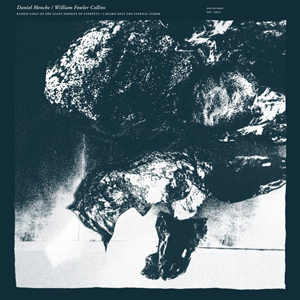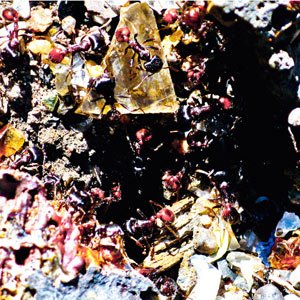Daniel Menche/William Fowler Collins; Mesa Ritual
 New Mexico's William Fowler Collins might have a smaller discography than others who work in similarly bleak moods and sounds, but the quality of each has been impeccable. These two new releases, one split with legendary noise artist Daniel Menche and the other a collaboration with Raven Chacon (Death Convention Singers), is up to the same standard, and conveys the barren and hostile, yet beautiful desert environment he hails from.
New Mexico's William Fowler Collins might have a smaller discography than others who work in similarly bleak moods and sounds, but the quality of each has been impeccable. These two new releases, one split with legendary noise artist Daniel Menche and the other a collaboration with Raven Chacon (Death Convention Singers), is up to the same standard, and conveys the barren and hostile, yet beautiful desert environment he hails from.
The split release has both Menche and Collins going in very different directions as far as composing and instrumentation, but the two pieces pair together beautifully.Menche heavily utilizes organ and brass instruments in ways they surely were not intended to be, mixed with his traditional electronics and processing."Raised Coils of the Giant Serpent of Eternity" might lead off with a relatively untreated, shimmering organ sound, but drifts more into darkness and noise.A crunchy, overdriven distorted edge appears, but never does the piece become a pure wall of noise.Instead, sweeping and buzzing sounds mix with grandiose sounding synth-like sounds, slowly building into a dense and intense composition.
Collins' contribution, "I Heard Only the Eternal Storm," is comparably more understated.Heavily utilizing guitar throughout, he builds from heavily reverberated plucked strings into shrill passages and echoing, cavernous sounds.Expanding into an abyss of grinding noise and churning reverb, shrill string scrapes conjure images of Psycho in a scorched desert.Eventually fading to a chugging, engine like drone, the piece ends with a light, almost shoegazy guitar drone.
 
samples:
- Daniel Menche-Raised Coils of the Giant Serpent of Eternity (Excerpt 1)
- Daniel Menche-Raised Coils of the Giant Serpent of Eternity (Excerpt 2)
- William Fowler Collins-I Heard Only the Eternal Storm
 While the split release might show a greater variance of sounds and moods, his collaboration as Mesa Ritual with Chacon is more enmeshed in dissonance and noise.Pieces like "Procession II" and "Procession III" sees the duo heavily using crunchy overdriven static and pairing extremely high and low frequencies, a classic power electronics approach."Procession VI", on the other hand, stays within a jet engine like roar, with heavy echo and low frequency thuds fleshing out the sound a bit.
While the split release might show a greater variance of sounds and moods, his collaboration as Mesa Ritual with Chacon is more enmeshed in dissonance and noise.Pieces like "Procession II" and "Procession III" sees the duo heavily using crunchy overdriven static and pairing extremely high and low frequencies, a classic power electronics approach."Procession VI", on the other hand, stays within a jet engine like roar, with heavy echo and low frequency thuds fleshing out the sound a bit.
The latter half of the album is where a greater sense of experimentation starts to unfold."Procession VII" is all clinical, cold static textures and bassy drum pulses, and with its digital cleanliness and erratic rhythm structure it sounds like an extra harsh Raster-Noton release."Procession VIII" has the duo throwing in an unabashed kick drumbeat, with a looped, almost like melodic structure.It lies somewhere between music and chaos, It eventually drifts more into sharp digital noise at the end, taking the sound back to the noise of the first half.
The western desert environment colors Collins' and Chacon's work, but it is only on "Low Mountain" that the influence feels overt via windstorm like rustling and desolate expanses of sound.The subtler influence of that, however, helps define their work without it being a crutch.From the noise of Mesa Ritual to the moody lurch of his half of the Menche split, there is a feel of cohesion even when the sound widely diverges.Both of these albums have different sensibilities to them, but both show Collins, as well as Menche and Chacon, are at the top of their game.
samples:
 



